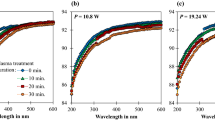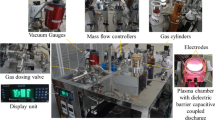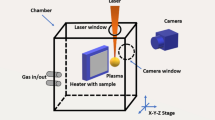Abstract
We report on an atmospheric pressure plasma (APP) treatment of fused silica and its related surface and near-surface effects. Such treatment was performed in order to improve laser micro-structuring of fused silica by a plasma-induced modification of the glass boundary layer. In this context, an APP jet applying a hydrogenous process gas was used. By the plasma treatment, the transmission of the investigated glass samples was significantly decreased. Further, a decrease in the superficial index of refraction of approx. 3.66 % at a wavelength of 636.7 nm was detected ellipsometrically. By surface energy measurements, a decrease of the surface polarity of 30.23 % was identified. These determined modifications confirm a reduction of silicon dioxide to UV-absorbing silicon suboxide as already reported in previous work. Further, a change in reflexion by maximum 0.26 % was detected which is explained by the superposition of constructive and destructive interferences due to a surface wrinkling. With the aid of atomic force microscopy, an increase of the surface root mean squared roughness by a factor of approx. 19 was determined. It was found that both the surface energy and the strength of the fused silica surface were reduced by the plasma treatment. Even though such treatment led to a clustering of carbonaceous contaminants, a surface-cleaning effect was confirmed by secondary ion mass spectroscopy and energy-dispersive X-ray spectroscopy. The increase in UV-absorption allows enhanced laser ablation results as shown in previous work.








Similar content being viewed by others
References
Belkind A, Gershman S (2008) Plasma cleaning of surfaces. Vac Tech Coat 11(2008):46–57
Tendero C, Tixier C, Tristant P, Desmaison J, Leprince P (2006) Atmospheric pressure plasmas: a review. Spectrochim Acta B 61:2–30
Saito Y, Hirayama H, Suzaki M, Tsuda Y (2005) Dry cleaning process of glass substrate surfaces by atmospheric plasma. In: Proceedings of the ICEE, PS3-01, ICEE-F0127
Hong SM, Kim SH, Kim JH, Hwang HI (2006) Hydrophilic surface modification of PDMS using atmospheric RF plasma. J Phys Conf Ser 34:656–661
Yamamoto T, Okubo M, Imai N, Mori Y (2004) Improvement on hydrophilic and hydrophobic properties of glass surface treated by nonthermal plasma induced by silent corona discharge. Plasma Chem Plasma Process 24:1–12
Kim S, Dao V, Choi H (2011) One atmospheric pressure plasma treatment of FTO glass for improving the efficiency of DSSC. In: 219th ECS meeting C1
Kim Y, Bae D, Kim Y (2005) LCD glass cleaning by atmospheric pressure glow discharge plasma. Key Eng Mater 297–300:2351–2355
Selwyn GS, Herrmann HW, Park J, Henins I (2001) Materials processing using an atmospheric pressure, RF-generated plasma source. Contrib Plasma Phys 6:610–619
Wang B, Zhao Q, Wang L, Dong S (2006) Application of atmospheric pressure plasma in the ultrasmooth polishing of SiC optics. Mater Sci Forum 532–533:504–507
Zhang J, Wang B, Dong S (2008) Application of atmospheric pressure plasma polishing method in machining of silicon ultra-smooth surfaces. Front Electr Electron Eng China 3:480–487
Fanara C, Shore P, Nicholls JR, Lyford N, Kelley J, Carr J, Sommer P (2006) A new reactive atom plasma technology (RAPT) for precision machining: the etching of ULE® surfaces. Adv Eng Mater 8:933–939
Johansen IT (1966) Electrical conductivity in evaporated silicon oxide films. J Appl Phys 37:499–507
Philipp HR (1971) Optical properties of non-crystalline Si, SiO, SiOx and SiO2. J Phys Chem Sol 32:1935–1945
Schumann L, Lehmann A, Sobotta H, Riede V, Teschner U, Hübner K (1982) Infrared studies of reactively sputtered SiOx films in the composition range 0.2 ≤ x ≤ 1.9. Phys Status Solidi B 110:K69
Gerhard C, Tasche D, Brückner S, Wieneke S, Viöl W (2012) Near-surface modification of optical properties of fused silica by low-temperature hydrogenous atmospheric pressure plasma. Opt Lett 37:566–568
Förster S, Mohr C, Viöl W (2005) Investigations of an atmospheric pressure plasma jet by optical emission spectroscopy. Surf Coat Technol 200:827–830
Manley TC (1943) The electric characteristics of the ozonator discharge. ECS Trans 84:83–96
Helmke A, Hoffmeister D, Mertens N, Emmert S, Schuette J, Viöl W (2009) The acidification of lipid film surfaces by non-thermal DBD at atmospheric pressure in air. New J Phys 11:115025
Hoffmeister J, Gerhard C, Brückner S, Ihlemann J, Wieneke S, Viöl W (2012) Laser micro-structuring of fused silica subsequent to plasma-induced silicon suboxide generation and hydrogen implantation. Phys Proc 39:613–620
Levin IM, Khotimchenko VS, Sochivkin GM (1985) Concentration of hydrogen and water in fused silica blanks. Glass Ceram 42:359–361
Brückner S, Hoffmeister J, Ihlemann J, Gerhard C, Wieneke S, Viöl W (2012) Hybrid laser-plasma micro-structuring of fused silica based on surface reduction by a low-temperature atmospheric pressure plasma. J Laser Micro/Nanoeng 7:73–76
Heraeus Quarzglas GmbH & Co. KG (2011) Datasheet HQS-SO Quarzglas für die Optik. Daten und Eigenschaften
Schweikart A, Fery A (2009) Controlled wrinkling as a novel method for the fabrication of patterned surfaces. Microchim Acta 165:249–263
Kaelble DH (1969) Peel adhesion: influence of surface energies and adhesive rheology. J Adhesion 1:102–123
Owens DK, Wendt RC (1969) Estimation of the surface free energy of polymers. J Appl Polym Sci 13:1741–1747
Paul A (1990) Chemistry of glasses. Chapman and Hall, London
Bliedtner J, Gräfe G (2008) Optiktechnologie. Carl Hanser Verlag, München
Lyubochko VA, Malikov VV, Parfenov OG, Belousova NV (2000) Reduction of aluminium oxide in a nonequilibrium hydrogen plasma. J Eng Phys Thermophys 73:568–572
Rains RK, Kadlec RH (1970) The reduction of Al2O3 to aluminum in a plasma. Metall Trans B 1:1501–1506
Lide DR (ed) (1991) CRC handbook of chemistry and physics. CRC Press, Boca Raton
Acknowledgments
This work was supported by the European Regional Development Funds (EFRE) and the Workgroup Innovative Projects of Lower Saxony (AGiP) in the frame of the Lower Saxony Innovation Network for Plasma Technology (NIP), project funding reference number W2-80029388. Further, the authors thank René Gustus from the Institute of Energy Research and Physical Technologies at the Clausthal University of Technology, Jürgen Ihlemann from the Laser Laboratory Göttingen, Benedikt Ernst from the Institute of Material Physics at the University of Göttingen, Gesa Pähler and Augusto Cardenas from the Institute of Physical Chemistry at the University of Göttingen, Jennifer Hoffmeister and Jörn Heine from the University of Applied Sciences and Arts in Göttingen as well as Kirsten Schiffmann from the Fraunhofer-Institute for Surface Engineering and Thin Films in Brunswick for the help during the measurements.
Author information
Authors and Affiliations
Corresponding author
Rights and permissions
About this article
Cite this article
Gerhard, C., Weihs, T., Tasche, D. et al. Atmospheric Pressure Plasma Treatment of Fused Silica, Related Surface and Near-Surface Effects and Applications. Plasma Chem Plasma Process 33, 895–905 (2013). https://doi.org/10.1007/s11090-013-9471-7
Received:
Accepted:
Published:
Issue Date:
DOI: https://doi.org/10.1007/s11090-013-9471-7




